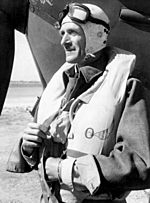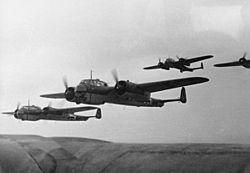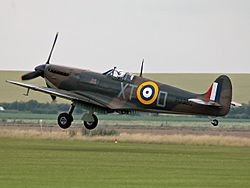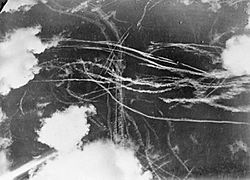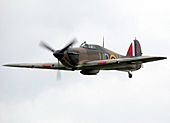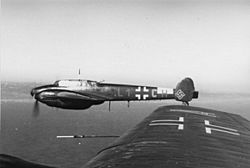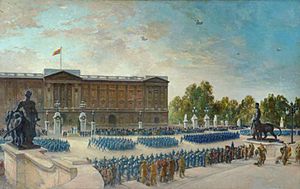Battle of Britain Day facts for kids
Quick facts for kids Battle of Britain Day |
|||||||
|---|---|---|---|---|---|---|---|
| Part of the Battle of Britain | |||||||
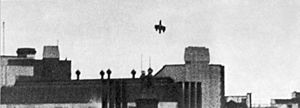 Dornier Do 17 of Kampfgeschwader 76 falling on Victoria Station, Sunday 15 September 1940 |
|||||||
|
|||||||
| Belligerents | |||||||
| Commanders and leaders | |||||||
| Units involved | |||||||
| Strength | |||||||
| 50,000 observers 630 fighter aircraft |
1,120 aircraft (620 fighters and 500 bombers) | ||||||
| Casualties and losses | |||||||
| 29 aircraft destroyed ~ 21 damaged 14–16 killed 14 wounded 1 captured |
58 aircraft destroyed 20 severely damaged 63–81 killed 63–65 captured 30–31 wounded 21 missing |
||||||
Battle of Britain Day, on 15 September 1940, was a very important day during the Battle of Britain. It was when a huge air battle happened over England.
In June 1940, Germany had taken over most of Western Europe and Scandinavia. The only major power left to stand against them was the British Empire. Germany's leader, Adolf Hitler, wanted to invade Britain. But first, he needed his air force, the Luftwaffe, to destroy the British Royal Air Force (RAF). This would give Germany control of the skies.
The Battle of Britain began in July 1940. The Luftwaffe first attacked ships in the English Channel. Then, in August, they started bombing RAF airfields in southern England. Hitler was not happy with the results. So, in early September, the Germans changed their plan. They began bombing British cities, especially London. Their goal was to damage factories and lower the spirits of the British people.
On Sunday, 15 September 1940, the Luftwaffe launched its biggest attack yet on London. They hoped to force the RAF into a huge battle and destroy it. About 1,500 aircraft fought in the skies that day, from morning until evening. This day was the most intense part of the Battle of Britain. The RAF successfully defended against the German raids. The Luftwaffe attacks did not cause severe damage to London. After this defeat, Hitler decided to delay his invasion plan. The Luftwaffe then focused on night bombings, known as The Blitz, which lasted until May 1941.
Today, Battle of Britain Day, 15 September, is remembered every year in the United Kingdom. In Canada, it is celebrated on the third Sunday of September.
Contents
Why the Battle Happened
In 1940, Germany had conquered much of Europe. Britain was the main country still fighting them. Hitler wanted to invade Britain, but he needed to control the skies first. So, he ordered the Luftwaffe to defeat the RAF. This invasion plan was called Operation Sea Lion.
The Battle of Britain started on 10 July 1940. German bombers first attacked British ships and ports. Then, they began bombing RAF airfields. This part of the plan was called "Operation Eagle Attack." On 13 August, known as "Eagle Day," the Luftwaffe launched its biggest attack so far, but it failed. The battles continued, with both sides losing many planes.
Hitler was not happy with the slow progress. After the RAF bombed Berlin in late August, Hitler ordered the Luftwaffe to focus on London. He thought this would draw out the RAF and lead to a decisive battle. The first major daylight attack on London was on 7 September. It caused a lot of damage and hurt many civilians.
Bad weather stopped large attacks for a few days. This gave the RAF time to prepare. Hugh Dowding, who led RAF Fighter Command, got his forces ready. The British knew the Germans were changing their strategy to attack London. They prepared for more raids on the capital.
German Plans for the Attack
On 14 September, Hitler and his military leaders met in Berlin. They talked about the war. Hitler praised the attacks so far but blamed the weather for not achieving a full victory. He knew that without control of the air, the invasion of Britain could not happen.
Hitler still wanted to threaten an invasion. He ordered the Luftwaffe to keep attacking military targets in London. The Luftwaffe planned a two-part attack for 15 September.
Their main targets were military. The first target was Battersea railway station in London. This station was important because it linked London to industrial cities in Britain. Destroying it would hurt Britain's ability to move supplies.
The second target was the Thames Estuary dock areas. This included the East End of London warehouses and the Royal Docks. These docks were vital for bringing in supplies from other countries, like North America.
German Intelligence and Mistakes
The German plan depended on their intelligence being correct. They thought the RAF was almost defeated. They believed that by attacking key targets in London, the RAF would be forced to defend them, and the remaining British fighters could be destroyed. This would give Germany air superiority, cut off supplies, and hurt British morale.
However, the German intelligence was wrong. The RAF was not on its last legs. The British had been given a much-needed rest when the Germans switched to bombing cities. British radar was still working well. It could spot German planes forming up over France long before they reached Britain. This gave the RAF plenty of warning. Also, flying to London meant German bombers had to fly longer distances in enemy airspace, making them more vulnerable.
Hitler was satisfied with the Luftwaffe's plan. He believed attacking London would lead to a big battle where the RAF would be destroyed. Most of the fighting on 15 September would be between Luftflotte 2, led by Albert Kesselring, and Keith Park's No. 11 Group RAF.
British Plans for Defence
The "Big Wing" Idea
Air Vice-Marshal Trafford Leigh-Mallory and Squadron Leader Douglas Bader played important roles in the September battles. Bader led No. 242 Squadron RAF with Hurricanes in Leigh-Mallory's 12 Group. This group defended industrial areas. Leigh-Mallory and Bader were frustrated that their squadrons were not used more often in the main battles over southeast England.
Bader wanted 12 Group fighters to take off as soon as German planes were spotted over France. He believed they could gather a large force, like three to five squadrons, to attack the enemy. This "Big Wing" tactic aimed to break up German formations before they reached their targets. Bader thought this would save RAF pilots in 11 Group from heavy losses.
However, Dowding saw 12 Group as a reserve force for 11 Group. Leigh-Mallory and Bader wanted to use this reserve immediately, which was the opposite of Dowding's plan. While the "Big Wing" might have saved 11 Group, it often took too long to get such large formations into position. They often ended up fighting the enemy as they were leaving, rather than before they dropped their bombs.
Park's Strategy: Avoiding Destruction
Keith Park, with Dowding's support, chose a different strategy. Park believed it was more important to protect his own forces than to inflict huge losses on the Germans. He thought the Germans would give up if they couldn't achieve their goal of air superiority. This meant keeping Fighter Command strong and ready.
Park sent small numbers of fighters to intercept the enemy. This helped to keep British losses low. By always having fighters available, the RAF made sure the Luftwaffe could not win. As long as the RAF could make the Germans pay a price before they bombed, the British defence system would remain intact for the next day. Park's strategy was to stop the enemy before they hit their targets, even if it meant fewer German planes were shot down overall. Under the circumstances, Park and Dowding's strategy was the smarter choice.
The Air Forces Involved
German Luftwaffe Forces
The Luftwaffe had lost many planes since the Battle of Britain began. On 17 August, they had 2,226 planes ready. By 7 September, this dropped to 1,895. However, they were still producing new planes to replace losses.
The Luftwaffe had reorganized its air fleets. Luftflotte 2, based in the Netherlands, Belgium, and France, had the most aircraft. On 7 September, it had 1,311 planes, including many Messerschmitt Bf 109 fighters and medium bombers.
Many German aircrews were tired or had been killed or captured. This meant that many units were not at full strength. For example, by 14 September, Bf 109 units had only 67% of their crews ready.
British RAF Forces
The RAF had managed to keep its strength much better than the Luftwaffe thought. On the evening of 14 September, Fighter Command had 269 Supermarine Spitfires and 533 Hawker Hurricanes ready. The two most important groups, 11 Group and 12 Group, had over 500 fighters combined.
However, the RAF had lost many experienced pilots. By mid-September, Fighter Command had 1,492 pilots ready, but they needed 1,662. Many new pilots needed experienced leaders. Hugh Dowding's plan was to move fresh squadrons from quieter areas to replace those fighting in the southeast. This system was starting to struggle, but by 15 September, the RAF still had enough effective units to fight.
Morning Attack: 10:10 to 13:00
The main German attack started at 10:10 AM. Major Alois Lindmayr led the bomber formation. His unit, I./Kampfgeschwader 76 (KG 76), usually had 27 bombers, but after many losses, they only had eight Dornier Do 17s. Another group, III./KG 76, had 19 Do 17s. They met near Amiens and then flew to Cap Gris Nez to pick up their Messerschmitt Bf 109 fighter escort. Some bombers were in bad condition from earlier battles.
British Response
At RAF Uxbridge, where the air battles were controlled, Prime Minister Winston Churchill was visiting. At 10:30, British radar at Dover picked up the first German planes. The control room quickly identified them as hostile. They warned RAF commands across the south that over 40 enemy aircraft were entering British airspace.
By 11:04, the German bombers were near Calais. Lord Willoughby de Broke, a senior RAF controller, watched with Churchill and Park. He had to decide when to send up the RAF fighters. If he sent them too early, they might run out of fuel. If too late, the bombers would reach their targets. Park decided to send several squadrons from RAF Biggin Hill. He thought the raid might be a trick, with Bf 109s trying to clear the sky. But he took the chance and sent nine squadrons at 11:15.
No. 92 Squadron RAF and No. 72 Squadron RAF Spitfires took off from Biggin Hill. They were ordered to fly over Canterbury. Park then ordered more squadrons from other airfields to prepare. He now had many squadrons ready. Park even decided to test the "Big Wing" tactic. He ordered squadrons from RAF Duxford to meet the Germans over Hornchurch. Douglas Bader led 56 fighters from Duxford. They took off at 11:22.
The Battle Begins
The German Dorniers were protected by Bf 109 fighters. Some fighters flew ahead, while others stayed close to the bombers. The bombers flew slowly, forcing the fighters to slow down too, which made them easier targets. They crossed the British coast at Folkestone at 11:36. Strong headwinds slowed the German bombers even more, using up the Bf 109s' limited fuel. This also helped the RAF fighters coming from the north.
As the forces got closer, about 120 German Bf 109s and 25 Do 17s faced 245 British Spitfires and Hurricanes.
The Fight Over Kent
Park's plan worked. The Biggin Hill squadrons met the enemy over Canterbury. They attacked the German fighters from above. Spitfires tried to get through to the bombers but were blocked. Soon, more RAF squadrons joined the fight. The RAF broke up the top German escort. Many Hurricanes attacked the bombers head-on. The German bombers held their formation, but their escorts were busy fighting RAF planes all over Kent.
The Bf 109s had protected the bombers well so far. But Park's tactics forced them to use up fuel quickly in dogfights. When the German planes reached the outskirts of London, many Bf 109s had to leave at 12:07 to return to base.
The remaining German Dorniers were engaged by 20 Hurricanes. One German bomber, flown by Robert Zehbe, had engine trouble and fell behind. Ray Holmes of 504 Squadron, out of bullets, bravely rammed the bomber. The Dornier broke apart and crashed near London Victoria station. Its bombs fell near Buckingham Palace, causing damage. Zehbe parachuted out but died later from his injuries. Holmes' Hurricane was badly damaged, but he survived.
Directly over the target, Bader's Duxford Wing arrived and attacked the Germans as they were dropping their bombs. The bombs hit the Battersea rail lines near Battersea Park. They damaged the tracks and a bridge, stopping rail traffic for three days.

Within minutes, the German bomber formation was reduced to 15 aircraft, most of them damaged. Six had been shot down, and four were trying to escape. The rest dropped their bombs and returned to France.
In this morning attack, the Germans lost six bombers and 12 Bf 109s. The British lost 13 fighters.
Afternoon Attack: 13:45 to 15:45
Even as the first German bombers were landing, the next wave was taking off. Many bomber units, including Kampfgeschwader 2 (KG 2), Kampfgeschwader 3 (KG 3), Kampfgeschwader 53 (KG 53), and Kampfgeschwader 26 (KG 26), took off. Their targets were the West India Docks, Royal Victoria Dock, and the warehouses of the Surrey Commercial Docks. Jagdgeschwader 53 (JG 53) and Adolf Galland's Jagdgeschwader 26 (JG 26) were among the fighter escorts.
The German bombers, including 43 Do 17s, 24 Heinkel He 111s, 19 Do 17s, and 28 He 111s, flew towards Dungeness. The strong headwind made their flight difficult. German fighter pilots had to stay very close to the bombers, which they disliked because it made them vulnerable.
At 13:45, British radar picked up the new German raids. The RAF sent a single Spitfire to act as a spotter, reporting on the size and direction of the German formation. Radar operators estimated the German force to be about 225 aircraft, but it was actually much larger, with 475 planes. Park ordered his forces to use the same interception tactics as in the morning.
RAF Scramble
At 14:00, No. 11 Group sent 68 fighters into the air. Spitfires from RAF Hornchurch and No. 222 Squadron RAF flew to Sheerness. Hurricanes from RAF Debden and No. 257 Squadron RAF went to Chelmsford. More Hurricanes from RAF Kenley and No. 605 Squadron RAF were dispatched.
Five minutes later, the German bombers split into three groups heading for the coast. Park scrambled four more squadrons. When he saw many German Bf 109s flying ahead on free-hunting patrols, he scrambled eight more squadrons. This included Spitfires from RAF Biggin Hill and Hurricanes from RAF Northolt and RAF North Weald.
The "Big Wing" from Duxford, with 20 Spitfires and 27 Hurricanes, was ordered to Hornchurch. Other squadrons from RAF Tangmere and RAF Middle Wallop were also called into action.
By 14:20, Park ordered even more squadrons into the air, including the Polish No. 303 Squadron RAF. No. 10 Group RAF also joined the battle.
In total, the RAF had 276 Spitfires and Hurricanes in the air. The Germans outnumbered the British by two to one in this raid. More seriously, for every two RAF fighters, there were three German Bf 109s.
First Clashes
Over Romney Marsh, RAF squadrons engaged German fighters, losing one plane. The second wave of RAF Hurricanes attacked the German Do 17s head-on. A Hurricane and a Dornier collided, with both planes crashing. The German Bf 109s tried to break up the attacks, but they were not allowed to chase enemy fighters far from the bombers. This allowed RAF fighters to return and attack again. One British pilot, after his fighter was hit, aimed his plane at a Dornier and bailed out, destroying the bomber. The German bomber crews thought the British were desperate.
At 14:31, the German bombers reached the River Thames, and British anti-aircraft guns opened fire, damaging one Dornier.
At 14:35, Park and Churchill watched the battle. Churchill asked about reserves, and Park said 11 Group had none left. However, there were more aircraft in nearby sectors. Park had sent all available squadrons to London. If the Luftwaffe launched another attack, there would be very few squadrons left to defend. Park knew that low clouds would force the Germans to attack at low altitude. He ordered some squadrons to return early to create a small reserve. In total, 185 RAF fighters were ready to engage. The battle would involve over 600 aircraft.
The Main Battle
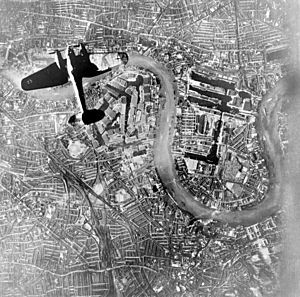
Near Gravesend, the German Do 17s of KG 3 and He 111s of KG 26 faced a strong attack from 63 RAF fighters. Hurricanes from 249 and 504 Squadrons attacked first, shooting down three Do 17s. The Bf 109s escorting KG 26 could only watch, as they were ordered to stay with their bombers.
As this happened, KG 53 was attacked by No. 1 (Canadian), 66, 72, and 229 Squadrons. Two He 111s were forced back to France, and another was shot down. KG 2 also came under attack from 23 Hurricanes.
Park was waiting for Bader's "Big Wing" to arrive. When it did, it was immediately intercepted by German fighters. The Hurricanes engaged the Bf 109s, while the Spitfires went for the bombers. This drew in many German fighters, making it easier for other RAF fighters to reach the bombers. By 14:40, the bombers reached London. Despite the British presence, 100 bombers with 120 tons of bombs prepared to drop their payload.
The low cloud base made it hard for RAF controllers to direct their squadrons accurately. The same clouds that protected the bombers also hid their targets. The bombers reached the Victoria Docks, but the targets were covered. So, they bombed West Ham instead, hitting a gas works and causing a blackout. Residential areas were also badly damaged. KG 2 could not find the Surrey Commercial Docks and dropped its bombs over a wide area. In West Ham, 17 people were killed, and many more were injured.
As the Germans retreated, many scattered, while others formed uneven groups and were chased by RAF fighters. With fuel running low, the Bf 109s headed back to France, unable to help the struggling bombers.
Many German bombers that had been forced out of formation were destroyed. Four Do 17s and six He 111s were shot down by RAF fighters swarming over Kent. The main German formations withdrew as more RAF squadrons closed in.
German losses in this raid were heavy. KG 2 lost eight Do 17s destroyed and seven damaged. KG 3 lost six destroyed and four damaged. KG 53 lost six Heinkels with two more damaged. German fighter units also suffered losses, with many Bf 109s destroyed.
In total, the Luftwaffe lost 21 bombers destroyed and at least 12 fighters. The RAF lost 15 fighters destroyed and 21 damaged.
Later in the afternoon, a group of over 20 He 111s attacked Royal Navy targets at Portland Harbour. They were intercepted by six Spitfires. The bombers dropped their bombs, causing minor damage to naval buildings. Nine civilians were killed in this attack.
Evening and Night Actions
One more important German operation happened before the day ended. At 17:40, 20 aircraft from Erprobungsgruppe 210 took off. Their target was the Spitfire factory at Woolston in Southampton. British radar picked them up, and RAF squadrons were sent to patrol the area.
The Germans reached the factory at 17:55. Anti-aircraft guns in Southampton fired at them. Luckily for the British, the Germans missed the factory. They did damage gas and water pipes and nearby homes. Nine civilians were killed. If they had hit the factory, it would have seriously hurt British fighter production.
More interceptions happened in the evening. Two He 111s were seen near London at 19:00, likely on reconnaissance missions. One was chased out to sea, flying on one engine.
Small groups of German bombers tried to attack London in the afternoon, but caused little damage. Other German units bombed Liverpool during the night, causing widespread damage but few casualties. RAF night fighters flew many sorties but had little success.
What Happened Next
Claims and Reality
After the battle, the British Air Ministry announced that 175–185 German aircraft had been shot down. This was a huge exaggeration. The actual number of German planes destroyed was much lower. Churchill was told the RAF had shot down 183 enemy aircraft for fewer than 40 losses.
The next day, a British flying boat arrived in New York City with news of the "record bag" of 185 enemy aircraft. The German Embassy tried to correct the numbers, but they were ignored. The Germans, in their own newspaper, claimed they destroyed 79 RAF aircraft for 43 losses. This was also an overstatement. RAF losses were 29 fighters.
Keith Park, the RAF commander, was angry about the exaggerated claims. He thought claiming 200 planes in one day was "nonsense." He believed the "Big Wing" tactic, which claimed many victories, was not as effective as it seemed. Park knew the actual loss ratio was 2:1 in Britain's favor. It was a good day for the RAF, but not their best.
Evaluating the Day
In the two main battles, both sides lost a similar number of fighters. The big difference was the number of bombers lost. The RAF had more success against the afternoon attack because there were more German bombers to target. The more bombers Germany sent, the more they lost.
Park's handling of the battle was excellent. He used an aggressive defence strategy. The "Big Wing" tactic, while its claims were exaggerated, did have a psychological effect. German aircrews were told the RAF was defeated, so seeing large formations of British fighters was a shock.
A German victory on Battle of Britain Day was very unlikely. Even if the losses had been reversed, the RAF had more planes and pilots available to continue fighting the next day.
The day after the battle, Hermann Göring, the head of the Luftwaffe, met with his staff. They believed the RAF had used all its fighters to defend London and was breaking. They thought a few more days of attacks would defeat the British. They also believed the British had only 300 fighters left. They planned to bomb British aircraft factories and continue bombing London day and night.
However, the Luftwaffe bomber crews were ordered to prepare for winter, suggesting the campaign was changing. The fighting over Britain gradually turned into a night bombing campaign, known as The Blitz.
Hitler's Reaction and Future Plans
Hitler was not too worried about the air battle's outcome. He had already thought that the invasion of Britain was too risky without complete control of the air. He decided the war with Britain would continue. He would keep threatening an invasion until 1941, using strategic bombing. Then, he planned to attack the Soviet Union, hoping that once the Soviets were defeated, Britain would negotiate for peace. On 17 September, he officially delayed Operation Sea Lion. He did not formally cancel it until March 1942.
Göring never fully believed in the invasion, and Hitler never believed the air campaign alone could win without the invasion. Hitler needed someone to keep pressure on Britain, and Göring was willing. The invasion forces were eventually broken up and moved east, towards the Soviet Union.
The Luftwaffe's bombing campaign against Britain continued, but it lacked a clear strategy. Targets changed often, and no single type of target was consistently attacked. This lack of focus contributed to the failure of the offensive.
The air campaign against Britain in 1940 and 1941 failed to end the war. As Hitler expanded Germany's military actions, the German army became spread too thin, fighting on many fronts. By 1944, the Allies were ready to launch Operation Overlord, the invasion of Western Europe. The Battle of Britain ensured that the Western Allies had a base in Britain from which to launch this crucial campaign.
Commemoration
Battle of Britain Day is now an annual event in the United Kingdom, celebrated on 15 September. In Canada, it is commemorated on the third Sunday of September.
See also
- May Day in England
- Minden Day
- Oak Apple Day
- St Crispin's day
- St George's Day in England
- Feast day of St Thomas Becket
- Trafalgar Day
Images for kids



